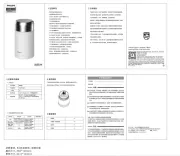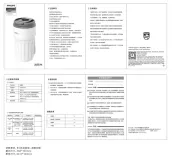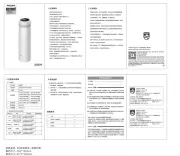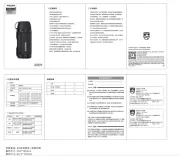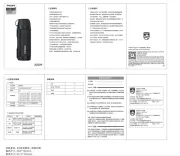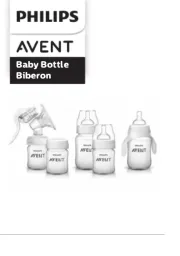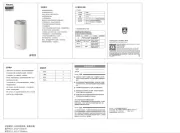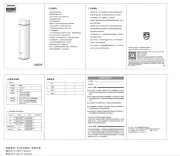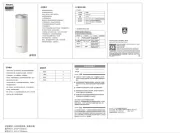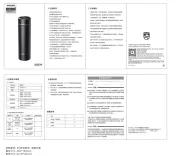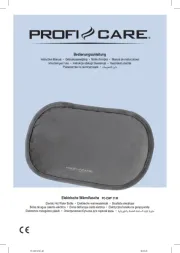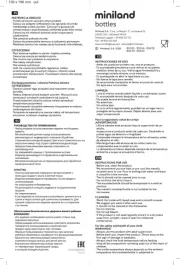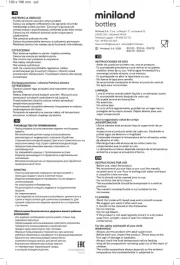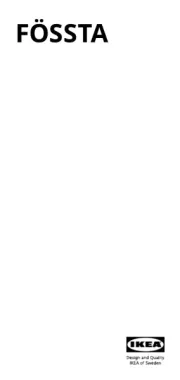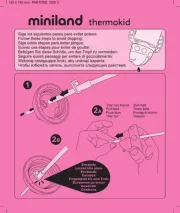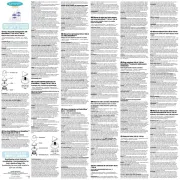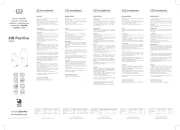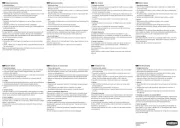
For your child’s safety and health
-Always use this product with adult
-Never use feeding teats as a
soother, to prevent chocking hazard.
-Continuous and prolonged sucking
of uids will cause tooth decay.
-Always check food temperature
-It is not recommended to use a
microwave to warm up baby‘s
food or drinks. Microwaves might
alter the quality of food/drinks and
destroy some valuable nutrients
and may produce localized high
temperatures. Therefore, take extra
care if and when you heat up food
-When heating up liquid or food
in the microwave, please only
place the container without
screw ring, teat and cap. Always
stir heated food to ensure even
heat distribution and check the
temperature before serving.
-Keep all components not in use out
of the reach of children.
-Do not allow child to play with
small parts or walk/run while using
-Do not place in a heated oven.
-Drinks other than milk and
water, such as fruit juices and
avored sugary drinks are not
recommended. If used, they should
be well diluted and only used for
-Expressed breast milk can
be stored in sterilized Philips
Avent bottles/containers in the
refrigerator for up to 48 hours (not
in the door) or in the freezer for up
to 3 months. Never refreeze breast
milk or add fresh breast milk to
-Always discard any breast milk that
is left over at the end of a feed.
-Do not use abrasive cleaning
agents or anti-bacterial cleaners.
Do not place components directly
on surfaces that have been cleaned
with anti-bacterial cleaners.
-Plastic material properties may
be aected by sterilizing and high
temperatures. This can aect the t
-Inspect before each use and pull
the feeding teat in all directions.
Throw away any part at the rst
signs of damage or weakness.
-Do not alter the product or parts
of it in any way. This may result in
unsafe functioning of the product.
Disassemble all parts and clean them
in warm soapy water and rinse them
thoroughly. Sterilize the parts in boiling
water for 5 minutes or by using a
Philips Avent sterilizer. This is to ensure
hygiene. During sterilizing in boiling
water, make sure that the pan contains
enough water and prevent the bottle
or other parts from touching the side
of the pan. This can cause irreversible
product deformation, defect or damage
that Philips cannot be held liable for.
Make sure that you wash your hands
thoroughly and that the surfaces are
clean before contact with sterilized
parts. Place all bottle parts on a clean
paper towel or on a clean drying rack
and allow them to air dry. Excessive
concentration of detergents may
eventually cause plastic components
to crack. Should this occur, replace
immediately. This product is dishwasher
safe - food colourings may discolour
parts. Clean and sterilize all parts before
each use. For hygiene reasons, we
recommend replacing teats after
When you assemble the bottle, make
sure you place the cap vertically onto
the bottle so that the teat sits upright
(see image for more details). To remove
the cap, place your hand over the cap
and your thumb in the dimple of the
cap. The teat is easier to assemble
if you wriggle it upwards instead of
pulling it up in a straight line. Make sure
you pull the teat through until its lower
part is even with the screw ring.
When not in use, do not store in
sunlight or heat, or leave in disinfectant
(‚sterilizing solution‘) for longer than
recommended, as this may weaken the
teat. Do not place in a heated oven.
Glass bottles may break. Do not use
metal inside the bottle to stir contents
or for cleaning. This can damage the
glass on the inside of the bottle. Before
each use, inspect bottles for sharp edges
or glass fragments inside. Do not use
bottles if there are any cracks on or glass
fragments in the bottle. Do not let babies
drink unsupervised with this bottle. Do
not use handles with glass bottles.
Prolonged wear or development of
scratches may lead to breakage.
Choosing the right teat for your baby
The Philips Avent teats are separately
available with dierent ow rates
to help your baby with drinking.
Over time you can change the teat
accommodating the individual needs
of your baby. Philips Avent teats
are clearly numbered on the side to
indicate ow rate. Make sure you use a
teat with the correct ow rate when you
feed your baby. Use a lower ow rate if
your baby chokes, is leaking milk or has
trouble adjusting to the drinking speed.
Use a higher ow rate if your baby falls
asleep during feeding, gets frustrated
or when feeding takes a very long time.
These Philips Avent teats can be used
on the Philips Avent feeding bottle and
Philips Avent storage cups.
(0) The teat for 0m can be used from
day one. Extra soft silicone teat and
it is the lowest ow rate available.
Recommended for newborn and
breastfed babies of all ages. The
number 0 is shown on the teat.
(1) The teat for 0m+ is recommended
for newborn and breastfed babies of
all ages. The number 1 is shown on
(2) The teat for 1m+ is recommended
for breastfed babies of all ages. The
number 2 is shown on the teat.
(3) The teat for 3m+ is recommended
for bottle fed babies at 3 months of
age and up. The number 3 is shown on
(4) The teat for 6m+ recommended
for bottle fed babies at 6 months of
age and up. The number 4 is shown on
(I/II/III) Variable ow: has a bite
resistant silicone teat. The sturdier teat,
with an adjustable ow rate to babies
convenience is recommended for bottle
fed babies at 3 months of age and up.
The teat has one slot cut on the top for
uid and the markings I, II, III on the edges
(Y) Thick feed: The thick feed
teat designed for thicker feeds is
recommended for bottle fed babies at
6 months of age and up. The teat has
one Y cut for uid and the symbol Y on
Note: Every baby is unique and your
baby‘s individual needs may vary from
the description of ow rates.
Note: Availability of spare teats may
-Make sure to choose the correct
teat corresponding to the correct
screw ring of your bottle: teats from
the Philips Anti-colic/Classic+ range
only t in screw rings of the Philips
Anti-colic/Classic+ range, and
Philips Pétala teats only t in Philips
-When you use a Philips Avent
sterilizer, please check on the website
how to place the Pétala bottle.
-The high quality plastic Pétala
bottle is compatible with
most Philips Avent breast pumps,
spouts, sealing discs and cup tops.
-The glass Pétala bottle is
compatible with Philips Avent
breast pumps and sealing discs.
For safety reasons, it is not
recommended to use glass Pétala
bottles with handles, spouts and
cup tops. If the bottle falls, it may
To locate a retailer or purchase
replacement bottle, teat or any Philips
Avent baby product, visit our website at
If you need information or support,
please visit .www.philips.com/support
Para a saúde e segurança do seu bebê
-O produto deve ser usado sempre
sob a supervisão de um adulto.
-Nunca use bicos como chupeta
para evitar o risco de engasgar.
-A sucção contínua e prolongada
enfraquecimento dos dentes.
-Sempre verique a temperatura do
alimento antes de dá-lo ao bebê.
-Não é recomendável usar micro-
ondas para aquecer alimentos ou
bebidas do bebê. Micro-ondas
podem alterar a qualidade dos
alimentos/bebidas e destruir
alguns nutrientes valiosos,
podendo também produzir altas
temperaturas localizadas. Portanto,
tenha cuidado redobrado se e
quando você aquecer alimentos no
-Ao aquecer líquidos ou alimentos
no micro-ondas, sempre coloque o
recipiente sem o anel de rosca, o bico
e a tampa. Sempre mexa os alimentos
aquecidos para garantir a distribuição
uniforme de calor e verique a
temperatura antes de servir.
-Mantenha todos os componentes
não utilizados fora do alcance das
-Não deixe o bebê brincar com as
partes menores ou andar/correr com
o copo ou a mamadeira na mão.
-Não coloque em forno aquecido.
-Bebidas diferentes de leite e água,
como suco de frutas e bebidas
açucaradas com sabor, não são
recomendadas. Se usados, devem
ser bem diluídos e usados somente
-É possível armazenar leite materno
em mamadeiras/recipientes
esterilizados Philips Avent dentro do
refrigerador por até 48 horas (sem
ser na porta) ou no freezer por até 3
meses. Nunca congele novamente
o leite materno descongelado nem
adicione leite materno fresco ao
-Sempre jogue fora o leite materno
que sobrar após amamentar o bebê.
-Não utilize agentes de limpeza
abrasivos ou antibacterianos.
Não coloque os componentes
diretamente sobre superfícies que
tenham sido limpas com produtos
-As propriedades dos materiais
plásticos podem ser afetadas
pela esterilização e pelas altas
temperaturas. Isso pode afetar o
-Examine antes de cada uso e puxe o
bico em todas as direções. Descarte
qualquer parte aos primeiros sinais
de danos ou deterioração.
-Não altere o produto nem partes
dele de nenhuma forma. Isso pode
resultar em funcionamento não
4213_354_4293_1_DFU-Leaflet_46x64_v3.indd 2 19/06/2018 14:01
